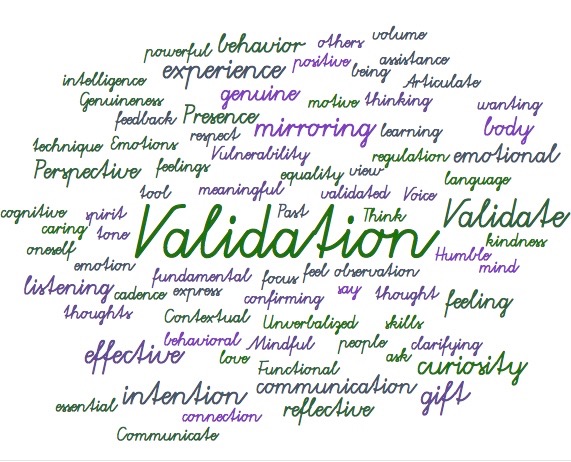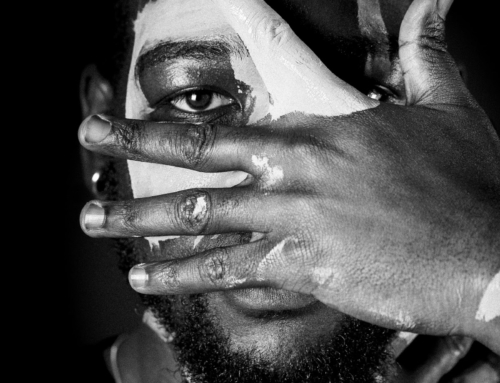Validation is not just something to give to others. It is also important to validate your own inner self.
Validation is a method for deep understanding. It can let others know you get it from their frame of reference. This requires that you truly see, hear and/or deeply know who and what you are trying to validate.
Validation doesn’t give anyone an excuse for their actions, nor does it make inappropriate behavior okay. You don’t have to agree with another to simply understand something their perspective.
A substantial level of social and emotional intelligence is required to truly validate. This skill can be as effective in the boardroom as it in the therapy room.
Ten Ways to Validate
Even with positive intention, validation can be tricky. When you want others to feel validated, proceed with these guidelines and an intention of love.
- Mindful Presence – Being fully and nonjudgmentally present for the other person in body, mind, and spirit. This is the gift of your full presence of being.
- Functional Recognition – If coming from a place of love, then consider an act of kindness or an offer of assistance. Folks sometimes want to give a hug or a tap on the arm, but best to ask permission before touching because physical contact can be aversive to more folks than you realize.
- Understanding from the Other’s Perspective – Use reflective listening skills. Accurately reflect back to the person your nonjudgmental observation and experience of what was said. Check in frequently with them to ensure that you indeed are getting it right. Also be sure to ask if there is more they want to say.
- Contextual Validation – Communicate how the behavior makes sense given the context or extenuating circumstances. Don’t worry this gives others an excuse — it doesn’t. However, it does let other know you get it.
- Mirroring – Reflect the non-verbals when it feels and seems natural to do so. This includes body language, tone, volume, cadence, and emotion.
- Causal Validation – Give voice to potential causes for a thought, feeling, or behavior, such as in terms of (1) past experience (new circumstance triggers old thoughts and feelings), (2) past learning (current circumstance combined with old way of doing things), (3) invalid information (got their information confused), (4) current biological disposition (think HALT – hungry, angry, lonely, tired).
- Vulnerability Matching – This is about self-disclosure and can be terribly tricky. Be sure to check your intention first. Engage with vulnerability only for the purpose of increasing emotional safety and trust — not to feel better yourself in some kind of way.
- Beware of Validation Drift – Remember that the person you are trying to validate is them and not you or someone else you know! The best rule of thumb is to not talk about anyone other than the person you wish to validate. If you just must bring in outside people or experience, try waiting for another time, and be sure to ask first if they want to hear it.
- Recognizing Unexpressed Feelings – Even those with much experience can get this one wrong. It is easy to think others are feeling what you are feeling, but this can be far from the truth. This is not a time to be declarative. But it can be helpful to ask what the other is actually feeling. The next step up is to ask for clarification around how their feelings seem to you.
- Exercising Humble Curiosity – Perhaps the highest respect you can give to another is to come from a place of humility, equality, acceptance, and nonjudgmental curiosity. This perspective allows the other their experience without them feeling your need for them to be any different than they are in that moment. It also treats others with dignity and plays to their strengths and not their fragility.
When you want folks to hear you, it generally helps when you validate them first. The best rule of thumb is to make sure that you come from a place of loving intention and humble curiosity.
Validation is such a powerful communication technique it is foundational to the effective therapeutic protocols of the DBT and ACT communities, and you can learn more about it there.
For now, simply remember this: Everyone — even your canine or feline — wants to be seen and heard in some way!!
Consider not only validating the experience of others but to validate the experience of your own inner self. When you listen to and validate your own inner spirit, its light will shine through you ever so brightly.
*****
Dr. Cindy Hardwick is the Trusted Leadership Advisor, Consulting & Licensed Psychologist, and ICF Credentialed Coach who brings you more than 37 years experience in the areas of individual and interpersonal transformation.
She integrates ancient philosophy with current research and best practices to facilitate meaningful change in individuals, relationships, and workplace cultures. She is known for her intuitive and nonjudgmental approach.
Cindy provides her own unique blend of Consulting and Coaching Psychology to those in positions of leadership and service to others to help you bring the best of who you are to your life and your work.
Learn more about Cindy at CynthiaHardwick.com
Visit her on Instagram, Twitter, LinkedIn, and Facebook.






